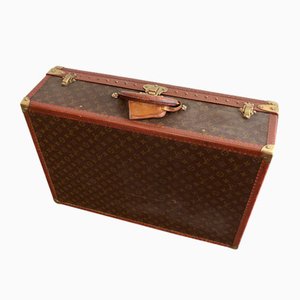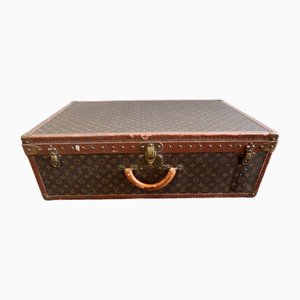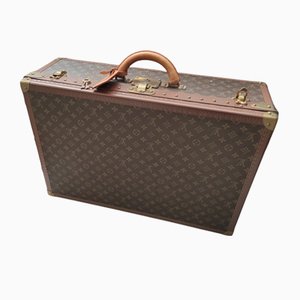
Louis Vuitton Malletier was founded by Louis Vuitton (1821-1892) in 1854 on Rue Neuve des Capucines in Paris, France. Today, with more than 460 stores in 50 countries worldwide, the company is one of the leading international fashion houses and most valuable luxury brands in the world, with a net worth valued at over 25 billion dollars.
Vuitton was born in Anchay in eastern France to a working class family in 1821. Both of his parents passed away while Vuitton was a young boy, and at the age of thirteen he left his hometown for Paris—a journey he made completely by foot. In 1937, after two years of travel, Vuitton settled in Paris, apprenticing as a layetier for box-maker and packer Monsieur Marechal. In 1854, Vuitton opened his own workshop specializing in packing fashions and quickly gained a reputation among Parisians for his craftsmanship.
In 1858, Vuitton had the novel idea of designing a flat-topped trunk—unlike the rounded-top trunks that were popular at the time—in a gray Trianon canvas; the result was in a lightweight, airtight, stackable trunk. It’s speculated that Vuitton drew his inspiration from H.J. Cave’s flat-topped Osilite trunk. Vuitton’s trunks, however, were designed to neatly store and organize wardrobes during long sea voyages and included an array of custom-made drawers and separate compartments. As demand for Vuitton’s trunks expanded, so did the company. In 1858, the workshop moved to Asnières, where it resides still.
Vuitton’s company was founded in an age of vast imperialist expansion. With the introduction of steamships and railroads, travel was suddenly easily accessible for the masses and allowed for safer and more comfortable journeys. During the grandeur of the Second Empire, Vuitton became the personal box-maker and packer to the Empress of France, Eugénie de Montijo. Soon, Vuitton was designing for other elite and royal clients, a status that the brand has maintained until today.
Vuitton knew his designs had to focus on functionality in order to meet the demands of the new nomadism. Travel, to Vuitton, was an art, and he understood there should be harmony between the container and the contents. His biggest success was being able to adapt to new modes of transportation and his customers’ growing demands. But soon, many other luggage manufacturers were copying Vuitton’s designs. To guard against counterfeiting, Vuitton developed the Rayée canvas, featuring red and white stripes in 1872, and beige and brown stripes in 1876. This canvas was used until the introduction of the Damier canvas—designed by Vuitton’s son, Georges Vuitton in 1888—which first appeared in the common light and dark brown checked pattern, and more rarely in a red and white checked pattern.
Georges Vuitton assumed control of the company after his father’s death in 1892. In 1896, he introduced the brand’s signature LV Monogram canvas in hopes of countering counterfeiters, which included a repetition of flowers, quatrefoils, and the infamous “LV” initials. The design echoes the “Orientalist” design trend of the late Victorian era. By 1913, the Louis Vuitton store on the Champs-Elysées in Paris was the largest travel goods store in the world.
After the death of Georges Vuitton in 1936, his son Gaston-Louis Vuitton ran the company. Gaston-Louis began to incorporate leather and to transform the Monogram canvas into a more pliable material for use in handbags and small leather accessories. Innovative designs by Gaston-Louis include the Steamer Bag (1901), which was initially designed to store dirty laundry during a long sea voyage; the Camp Bed Trunk (1905), which featured a fold-out bed and was designed for the French expeditioner Pierre Savorgnan de Brazza; and the Keepall Bag (1930).
In 1987, the company merged with Moët et Chandon and Hennessey to create LVMH, which is the largest luxury conglomerate in the world today. When Louis Vuitton started, all trunks were made to order specifically according to client preferences. The house continues this tradition while also commercializing readymade trunks sold in its stores. The most expensive custom order to date is the Louis Vuitton Michael Clarke Luxury Trunk, which was specially made for the captain of the Australian cricket team and is valued at $170,000.
In 2012, in homage to Louis Vuitton’s origins as a trunk maker, the company introduced Objets Nomades, a limited-edition collection of foldable furniture and travel accessories produced in collaboration with leading international designers, like Maarten Baas, Barber Osgerby, the Campana Brothers, Nendo, Raw Edges, and Patricia Urquiola. In 2016, Louis Vuitton showcased many of the pieces in their private collection at the Volez, Voguez, Voyagez exhibition at the Grand Palais in Paris and in Kioicho, Tokyo.
Over the years, Louis Vuitton has affiliated itself with numerous cultural icons, including David Bowie, Gisele Bündchen, Sean Connery, Nicolas Ghesquière (current artistic director), Marc Jacobs (artistic director 1997-2013), Angelina Jolie, Kim Jones, Annie Leibovitz, Madonna, Takashi Murakami, Keith Richards, Stephen Sprouse, and Pharrell Williams.
* All images courtesy of Louis Vuitton and LVMH






